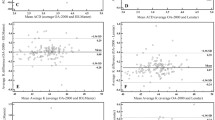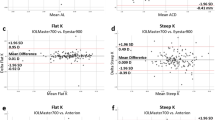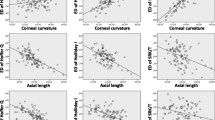Abstract
Purpose
To evaluate the accuracy of intraocular lens (IOL) power calculation in relation to optical biometry devices and refraction types.
Methods
Patients undergoing cataract phacoemulsification and insertion of the MX60 IOL were enrolled. Optical biometric measurements were performed with both IOLMaster 700 and Lenstar 900. Biometry measurements were compared between devices. A subsample of 133 eyes (81.1%) had examination for both autorefraction and subjective refraction postoperatively. The differences between the postoperative refraction and the refraction predicted by eight formulas (Kane, Hill-RBF 2.0, Barrett Universal II, Olsen, Haigis, SRK/T, Holladay 1 and Hoffer Q) were calculated.
Results
Overall, this study comprised 164 eyes of 164 patients. High agreement between the two biometers for axial length, average keratometry readings, anterior chamber depth, lens thickness and central corneal thickness was found (interclass correlation confidents: 0.999, 0.988, 0.965, 0.865 and 0.972, respectively, all P < 0.001). The absolute prediction error calculated with IOLMaster 700 measurements was significantly lower than that calculated with Lenstar 900 measurements for Olsen (P = 0.003), Haigis (P < 0.001) and Hoffer Q (P = 0.028). OPD-Scan III gave slightly more negative readings than subjective refraction (mean difference − 0.107 ± 0.553, P = 0.003 for spherical equivalent). However, no significant difference in absolute prediction error was found between the two refraction types per each formula.
Conclusion
IOLMaster 700 and Lenstar 900 showed good agreement in biometric measurements with a trend toward better refractive outcome using IOLMaster 700. The accuracy of IOL calculation assessed with OPD autorefraction was equivalent to that assessed with subjective refraction.




Similar content being viewed by others
References
Kanclerz P, Hoffer KJ, Rozema JJ, Przewłócka K, Savini G (2016) Biometry with a new swept-source optical coherence tomography biometer: repeatability and agreement with an optical low-coherence reflectometry device. J Cataract Refract Surg 42:577–581
Cruysberg LP, Doors M, Verbakel F, Berendschot TT, De Brabander J, Nuijts RM (2009) Evaluation of the Lenstar LS 900 non-contact biometer. Br J Ophthalmol 94:106–110
Arriola-Villalobos P, Almendral-Gómez J, Garzón N, Ruiz-Medrano J, Fernández-Pérez C, Martínez-de-la-Casa JM, Díaz-Valle D (2017) Agreement and clinical comparison between a new swept-source optical coherence tomography-based optical biometer and an optical low-coherence reflectometry biometer. Eye 31:437–442
Özyol P, Özyol E (2016) Agreement between swept-source optical biometry and Scheimpflug-based topography measurements of anterior segment parameters. Am J Ophthalmol 169:73–78
Asena L, Akman A, Gungor SG, Dursun Altınörs D (2018) Comparison of keratometry obtained by a swept source OCT-based biometer with a standard optical biometer and Scheimpflug imaging. Curr Eye Res 43:882–888
El Chehab H, Agard E, Dot C (2018) Comparison of two biometers: a swept-source optical coherence tomography and an optical low-coherence reflectometry biometer. Eur J Ophthalmol 29:547–554
Norrby S (2008) Sources of error in intraocular lens power calculation. J Cataract Refract Surg 34:368–376
Ostri C, Holfort SK, Fich MS, Riise P (2018) Automated refraction is stable 1 week after uncomplicated cataract surgery. Acta Ophthalmol 96:149–153
Hoffer KJ, Aramberri J, Haigis W, Olsen T, Savini G, Shammas HJ, Bentow S (2015) Protocols for studies of intraocular lens formula accuracy. Am J Ophthalmol 160:403–405
Kane JX, Van Heerden A, Atik A, Petsoglou C (2016) Intraocular lens power formula accuracy: comparison of 7 formulas. J Cataract Refract Surg 42:1490–1500
Kane JX, Van Heerden A, Atik A, Petsoglou C (2017) Accuracy of 3 new methods for intraocular lens power selection. J Cataract Refract Surg 43:333–339
Wallace HB, Misra SL, Li SS, McKelvie J (2018) Predicting pseudophakic refractive error: interplay of biometry prediction error, anterior chamber depth, and changes in corneal curvature. J Cataract Refract Surg 44:1123–1129
McGinnigle S, Naroo SA, Eperjesi F (2014) Evaluation of the auto-refraction function of the Nidek OPD-Scan III. Clin Exp Optom 97:160–163
Reitblat O, Levy A, Kleinmann G, Assia EI (2018) Accuracy of intraocular lens power calculation using three optical biometry measurement devices: the OA-2000, Lenstar-LS900 and IOLMaster-500. Eye 32:1244–1252
Srivannaboon S, Chirapapaisan C (2019) Comparison of refractive outcomes using conventional keratometry or total keratometry for IOL power calculation in cataract surgery. Graefes Arch Clin Exp Ophthalmol 257:2677–2682
Olsen T (2007) Calculation of intraocular lens power: a review. Acta Ophthalmol Scand 85:472–485
Cooke DL, Cooke TL (2016) Comparison of 9 intraocular lens power calculation formulas. J Cataract Refract Surg 42:1157–1164
Savini G, Hoffer KJ, Shammas HJ, Aramberri J, Huang J, Barboni P (2017) Accuracy of a new swept-source optical coherence tomography biometer for IOL power calculation and comparison to IOLMaster. J Refract Surg 33:690–695
Melles RB, Holladay JT, Chang WJ (2018) Accuracy of intraocular lens calculation formulas. Ophthalmology 125:169–178
Connell BJ, Kane JX (2019) Comparison of the Kane formula with existing formulas for intraocular lens power selection. BMJ Open Ophthalmol 4:e251
Melles RB, Kane JX, Olsen T, Chang WJ (2019) Update on intraocular lens calculation formulas. Ophthalmology 126:1334–1335
Acknowledgements
The authors thank Dr. Peizhen Zhao for statistical consultation and Dr. Jack X. Kane for his assistance with the optimization of lens constants.
Funding
This study was supported by grants from National Key Research and Development Program of China (No. 2017YFC1104603) and National Natural Science Foundation of China (No. 81770909).
Author information
Authors and Affiliations
Corresponding author
Ethics declarations
Conflict of interest
The authors declare that there is no conflict of interest.
Ethical approval
All procedures performed in studies involving human participants were in accordance with the ethical standards of the institutional and/or national research committee and with the 1964 Helsinki Declaration and its later amendments or comparable ethical standards.
Informed consent
A waiver of consent authorization was granted by the Ethics Committee of Zhongshan Ophthalmic Center for this retrospective study.
Additional information
Publisher's Note
Springer Nature remains neutral with regard to jurisdictional claims in published maps and institutional affiliations.
Rights and permissions
About this article
Cite this article
Cheng, H., Li, J., Cheng, B. et al. Refractive predictability using two optical biometers and refraction types for intraocular lens power calculation in cataract surgery. Int Ophthalmol 40, 1849–1856 (2020). https://doi.org/10.1007/s10792-020-01355-y
Received:
Accepted:
Published:
Issue Date:
DOI: https://doi.org/10.1007/s10792-020-01355-y




